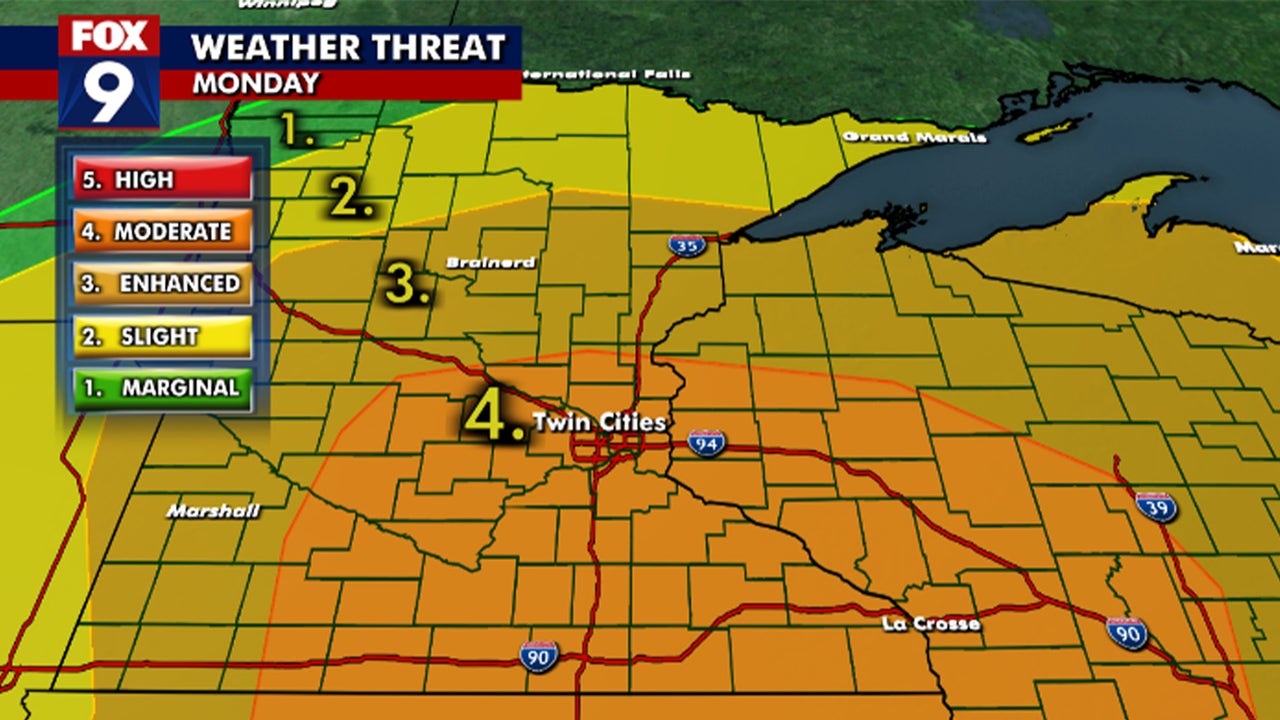Minnesota Severe Storms: Monday Timeline & Forecast – A Comprehensive Overview
Meta Description: A detailed look at Monday's severe storms in Minnesota, including a timeline of events, impact assessment, and a comprehensive forecast for the coming days. Stay informed about weather alerts and safety tips.
Meta Keywords: Minnesota severe storms, Monday weather, storm timeline, Minnesota weather forecast, severe weather alerts, tornado warning, hail damage, wind damage, flood warning, weather safety tips, Minnesota emergency services.
Introduction:
Minnesota experienced a significant severe weather event on Monday, [Insert Date], with widespread reports of damaging winds, large hail, torrential rainfall, and even isolated tornadoes. This article provides a comprehensive timeline of the storm's progression, details the impact across the state, and offers a detailed forecast for the coming days, emphasizing safety precautions and preparedness. The severity and widespread nature of this event highlight the importance of staying informed and prepared during severe weather seasons.
Timeline of Monday's Severe Storms:
(Note: Replace bracketed information with specific times and locations as they become available. This section requires real-time data updates based on the actual event.)
-
[Time]: The National Weather Service (NWS) issued the first severe thunderstorm watch for [County/Region] in western Minnesota. Initial reports indicated potential for strong winds and large hail.
-
[Time]: The first reports of severe weather began to emerge from [Location], with reports of [Specific weather event, e.g., golf ball-sized hail].
-
[Time]: The NWS upgraded the watch to a warning for [County/Region], indicating imminent danger from [Specific threats, e.g., tornadoes, damaging winds].
-
[Time]: A confirmed tornado touched down near [Location], causing [Extent of damage, e.g., damage to several homes and downed power lines]. Emergency services were immediately dispatched.
-
[Time]: Heavy rainfall caused flash flooding in [Location], leading to road closures and water rescues. Several motorists became stranded.
-
[Time]: The storm system moved eastward, impacting [County/Region] with [Specific weather event, e.g., damaging winds exceeding 70 mph].
-
[Time]: The NWS issued a flash flood warning for [County/Region] due to the intense rainfall.
-
[Time]: The severe thunderstorm warning expired for [County/Region] as the storm system weakened.
Impact Assessment:
The impact of Monday's severe storms was significant across numerous regions of Minnesota. Preliminary assessments indicate:
-
Property Damage: Numerous homes and businesses sustained damage from high winds, hail, and flooding. This includes [Specific examples, e.g., roof damage, broken windows, flooded basements]. A full assessment of the damage is still underway.
-
Power Outages: Thousands of homes and businesses experienced power outages due to downed power lines and damaged infrastructure. Utility crews are working diligently to restore power. [Insert names of affected utility companies and their estimated restoration times].
-
Agricultural Losses: Farmers across the state reported significant crop damage due to hail and strong winds. [Include details about specific crops affected and estimated economic losses if available].
-
Injuries and Fatalities: [Report number of injuries and fatalities, if any. If no injuries are confirmed, state this clearly.]
-
Transportation Disruptions: Numerous roads were closed due to flooding and debris. [Mention specific highway closures]. Air travel may have also been affected, with delays or cancellations at [Affected airports].
Detailed Forecast for the Coming Days:
The NWS predicts [Insert forecast for the next 2-3 days]. This includes:
-
Tuesday: [Specific forecast for Tuesday, including temperature, precipitation, and potential for severe weather]. Residents should remain vigilant and monitor weather updates.
-
Wednesday: [Specific forecast for Wednesday]. The risk of severe weather is [High/Low/Moderate].
-
Thursday and Beyond: [Specific forecast for Thursday and beyond]. The long-range forecast indicates [General trend, e.g., a return to more seasonable temperatures].
Safety Precautions and Preparedness:
The severity of Monday's storms highlights the critical importance of being prepared for severe weather. Here are essential safety tips:
-
Develop a Severe Weather Plan: Create a family emergency plan that includes evacuation routes, communication strategies, and a designated meeting place.
-
Stay Informed: Monitor weather forecasts and warnings from the National Weather Service (NWS) and local news sources. Sign up for weather alerts on your phone.
-
Prepare a Go-Bag: Assemble a kit containing essential supplies like water, non-perishable food, medications, flashlights, and a first-aid kit.
-
Know Your Shelter: Identify a safe room or shelter in your home where you can take refuge during a severe storm. This should be an interior room on the lowest level.
-
Secure Loose Objects: Before a storm hits, secure any loose objects outside that could become airborne, such as patio furniture, garbage cans, and garden decorations.
-
Stay Away from Windows: If a tornado warning is issued, stay away from windows to avoid flying debris.
-
Never Drive Through Floodwaters: Floodwaters can be deceptively deep and fast-moving. Turn around, don't drown.
-
Report Damage: After the storm, report any damage to your local authorities or emergency services.
Resources and Further Information:
-
National Weather Service (NWS): [Insert link to NWS website]
-
Minnesota Department of Public Safety: [Insert link to Minnesota DPS website]
-
[Local Emergency Management Agency]: [Insert link to your local EMA website]
Conclusion:
Monday's severe storms serve as a stark reminder of the potential for destructive weather in Minnesota. By staying informed, preparing adequately, and following safety guidelines, residents can significantly reduce their risk during severe weather events. Continuous monitoring of weather forecasts and adherence to warnings from official sources are crucial for ensuring safety and minimizing the impact of future storms. Remember to check on your neighbors and community members, especially those who may be vulnerable during such emergencies. The collective effort towards preparedness and community support is essential in mitigating the effects of severe weather events and ensuring the well-being of all Minnesotans.

